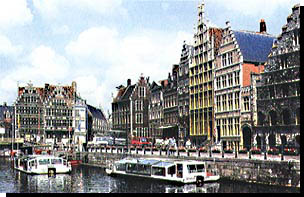  Guild Houses
| ||
|
GHENT Ghent, the capital of East Flanders, is about 36 miles west of Brussels, the capital of Belgium. Ghent's climate is much like Kanazawa's, except that Ghent receives less snow-fall. Well-kept parks and squares display the splendor of the local flower culture and contribute to Ghent's fame as the "City of Flowers." This fame is accentuated every five years by the "Ghent Floralies," a world-renowned flower show. Ghent's history dates back to the 17th century, when Saint Peter's Abbey and Saint Bavo's Cathedral were built, and its development took off after the completion of the Castle of the Counts in 1180. Today Ghent serves as an entrance port to Brussels; the city is a very important trade and industrial center, well-known for its textiles, iron, and steel. Ghent abounds in culture, both ancient and modern. The architecture of the Middle Ages has been preserved in many places like the old harbor with its guild houses at the Graslei and Korenlei. Furthermore, there are several museums, abbeys, beguinages, and dozens of churches. The Ghent University, founded in 1816, is the center of Flemish literature and Saint Bavo Cathedral's "The Adoration of the Mystic Lamb" by Jan van Eyck is considered to be the pinnacle of 15th-century Flemish painting. | ||
Exchange Activities
|
| |
| Click to enter the site of Ghent city! | ||
Ghent | Irkutsk | Buffalo | Nancy | Porto Alegre | Suzhou | Jeonju
Kanazawa's Sister Cities
